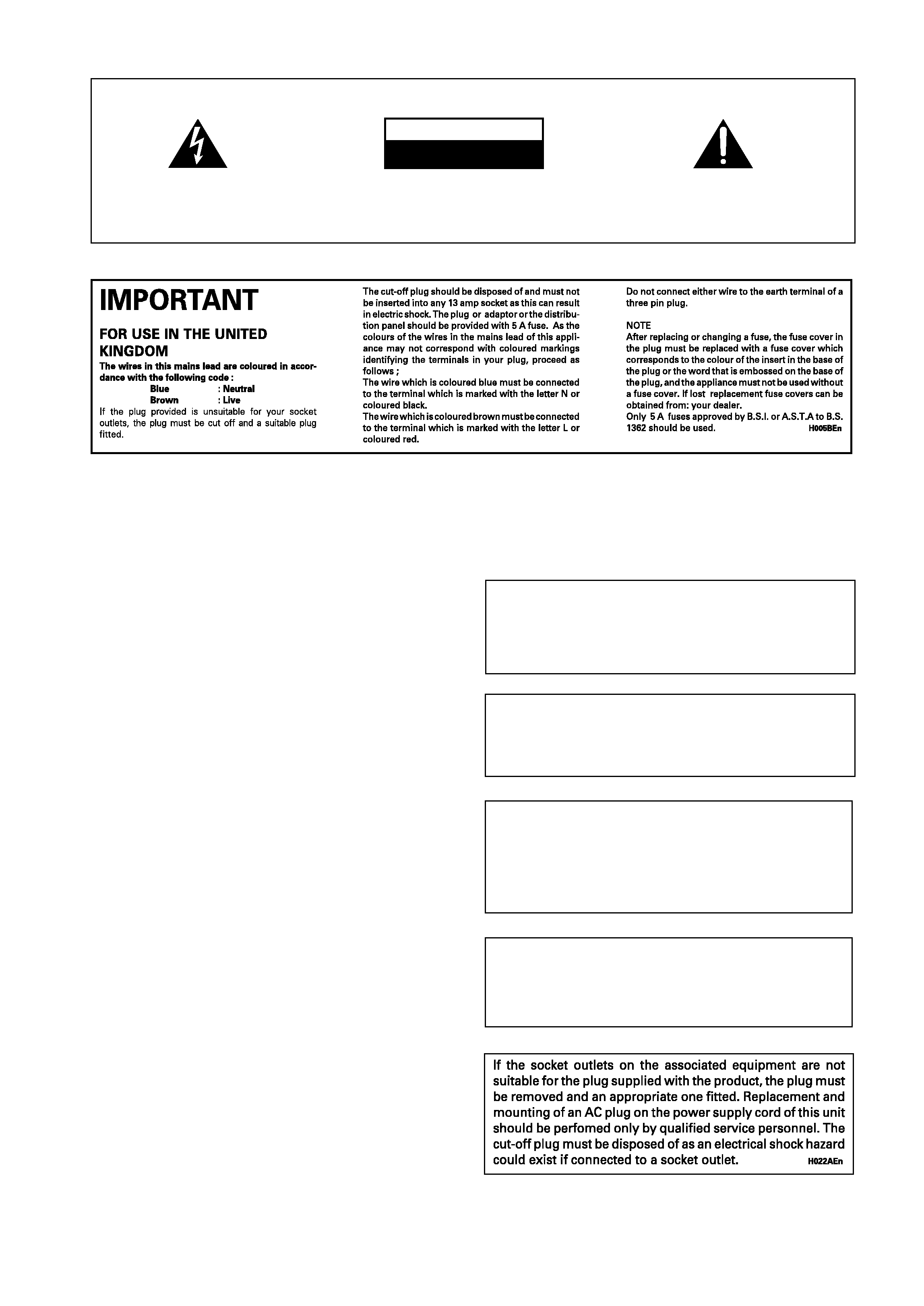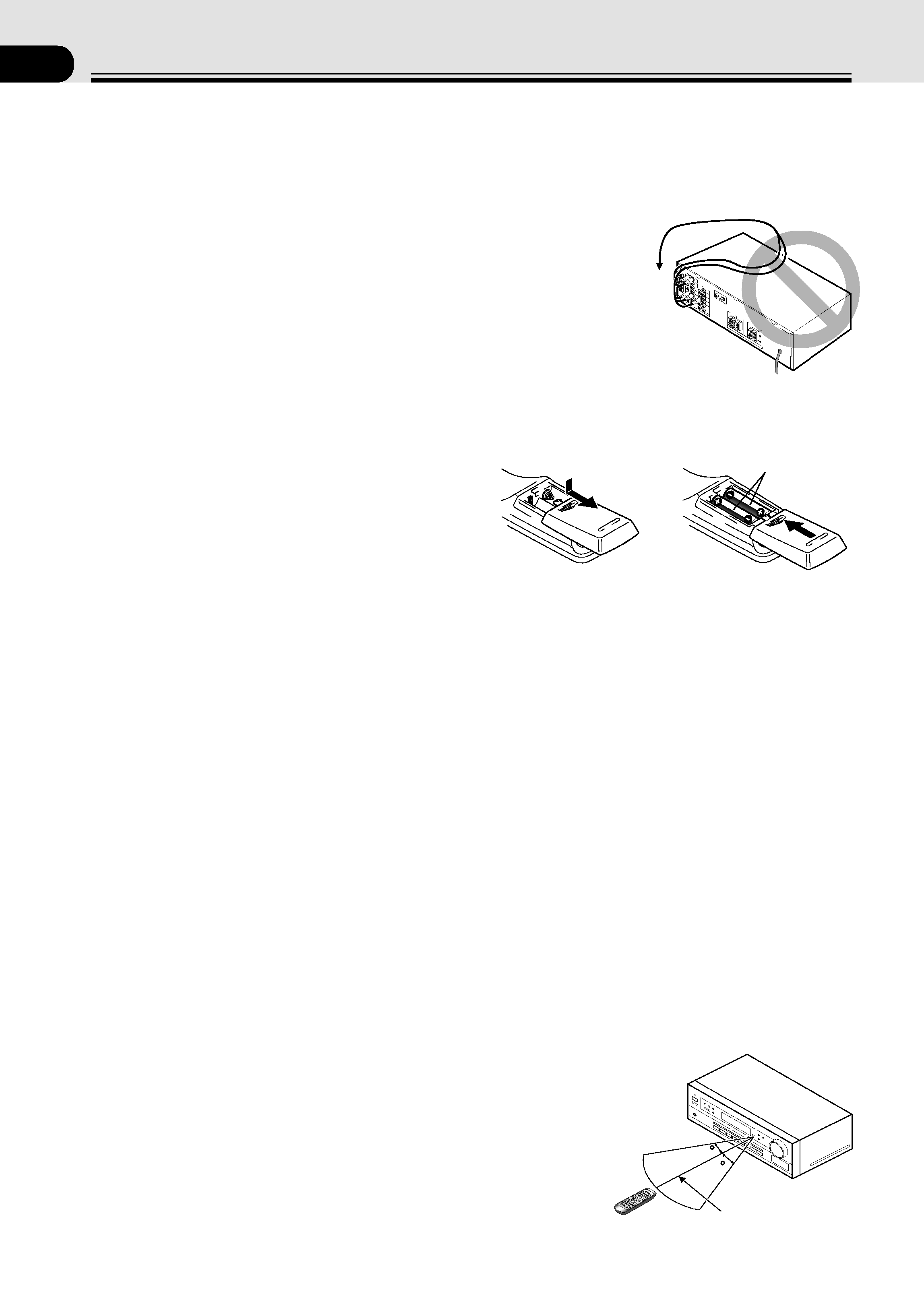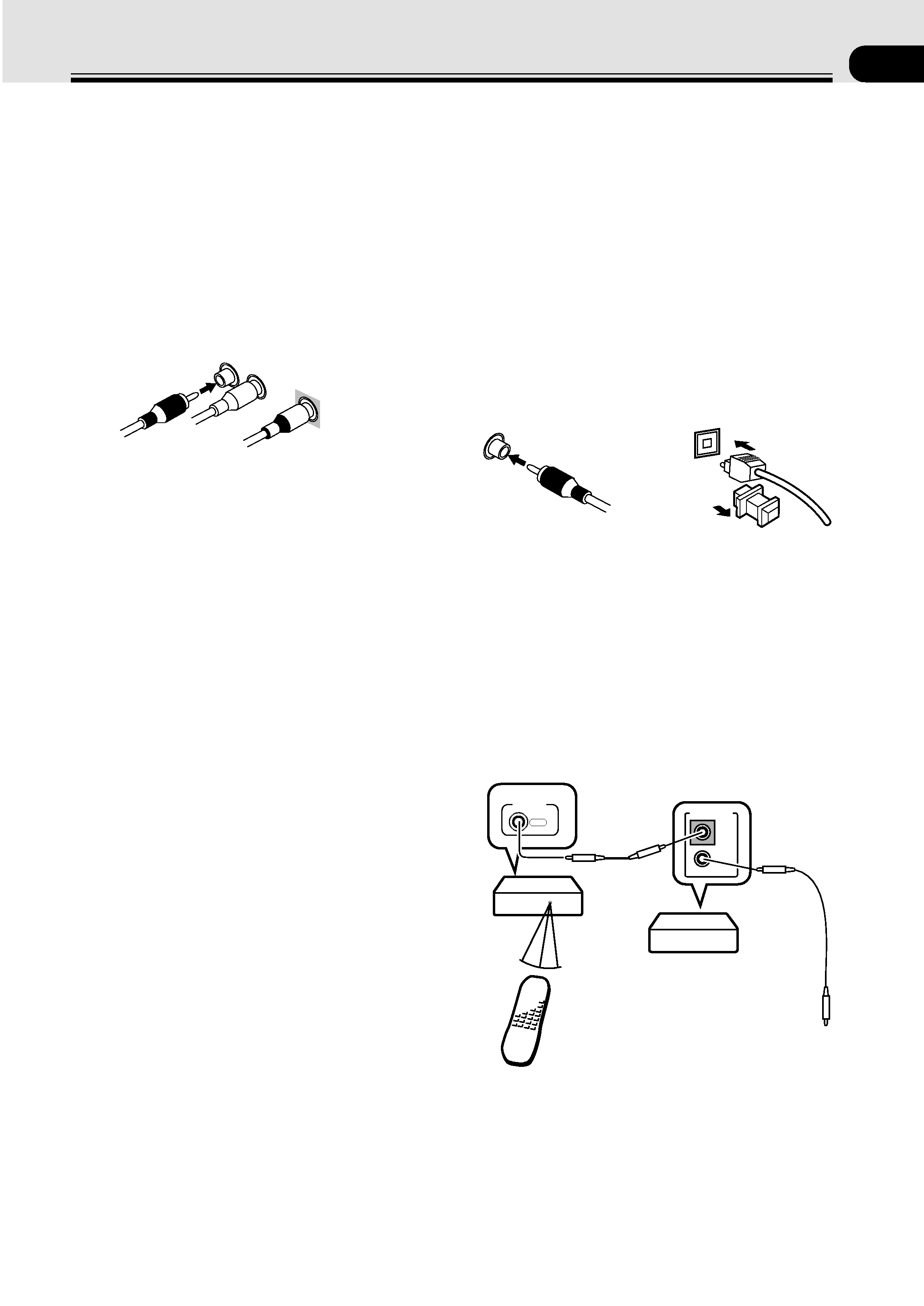
Operating Instructions
AUDIO/VIDEO
MULTI-CHANNEL RECEIVER
VSX-D510

2
En
RISK OF ELECTRIC SHOCK
DO NOT OPEN
CAUTION
IMPORTANT 1
CAUTION:
TO PREVENT THE RISK OF ELECTRIC SHOCK, DO
NOT REMOVE COVER (OR BACK).
NO USER-
SERVICEABLE PARTS INSIDE. REFER SERVICING TO
QUALIFIED SERVICE PERSONNEL.
The exclamation point within an equilateral triangle is
intended to alert the user to the presence of important
operating and maintenance (servicing) instructions in
the literature accompanying the appliance.
The lightning flash with arrowhead symbol, within an
equilateral triangle, is intended to alert the user to the
presence of uninsulated "dangerous voltage" within the
product's enclosure that may be of sufficient magnitude
to constitute a risk of electric shock to persons.
Thank you for buying this Pioneer product.
Please read through these operating instructions
so you will know how to operate your model prop-
erly. After you have finished reading the instruc-
tions, put them away in a safe place for future ref-
erence.
In some countries or regions, the shape of the
power plug and power outlet may sometimes dif-
fer from that shown in the explanatory drawings.
However, the method of connecting and operating
the unit is the same.
Power cord CAUTION!
Handle the power cord by the plug. Do not pull
out the plug by tugging the cord and never
touch the power cord when your hands are wet
as this could cause a short circuit or electric
shock. Do not place the unit, a piece of
furniture, etc., on the power cord, or pinch the
cord. Never make a knot in the cord or tie it with
other cords. The power cords should be routed
such that they are not likely to be stepped on. A
damaged power cord can cause a fire or give
you an electrical shock. Check the power cord
once in a while. When you find it damaged, ask
your nearest PIONEER authorized service center
or your dealer for a replacement.
WARNING: TO PREVENT FIRE OR SHOCK HAZARD,
DO NOT EXPOSE THIS APPLIANCE TO RAIN OR
MOISTURE.
THE
-- OFF/ _ ON BUTTON IS SECONDARY
CONNECTED AND THEREFORE DOES NOT
SEPARATE THE UNIT FROM MAINS POWER IN
STANDBY POSITION.
This product complies with the Low Voltage
Directive (73/23/EEC, amended by 93/68/EEC), EMC
Directives (89/336/EEC, amended by 92/31/EEC and
93/68/EEC).
Manufactured under license from Dolby
Laboratories. "Dolby", "Pro Logic" and the double-
D symbol are trademarks of Dolby Laboratories.
Confidential Unpublished Works. © 1992-1997
Dolby Laboratories, Inc. All rights reserved.
"DTS" and "DTS Digital Surround" are
trademarks of Digital Theater Systems, Inc.
Manufactured under license from Digital
Theater Systems, Inc.

3
En
01
01
Contents
Congratulations on buying this fine Pioneer product.
Please read through these operating instructions so you will know how to operate your model
properly. After you have finished reading the instructions, put them away in a safe place for
future reference.
01
Contents
3
02
Introductory Information
4
Checking the Supplied Accessories
4
Using this Manual
4
Installing the Receiver
4
When Making Cable Connections
4
Loading the Batteries
4
Operating Range of Remote Control Unit
4
03
Connecting Your Equipment
5
Operating Other Pioneer Components
5
Connecting Digital Components
6
Connecting Audio Components
6
Connecting DVD 5.1 Channel Components
7
Connecting Video Components
7
Connecting Antennas 8
Using External Antennas
8
Connecting Speakers
9
Hints on speaker placement
10
04
Preparations
11
Setting Up for Surround Sound
11
Setting the Volume Level of Each Channel
15
05
Displays & Controls
16
Display
16
Front Panel
17
Remote Control
18
06
Sound Modes
20
Learning about the Sound Modes
20
Switching ANALOG/DIGITAL Signal Input
21
Playing Sources with Dolby Digital or DTS Sound
21
Selecting a Sound Mode
22
Using in MIDNIGHT Listening Mode
22
ADVANCED THEATER Mode
( Dolby/DTS mode)
23
Playing Other Sources
23
07
Using the Tuner
24
Finding a Station
24
Tuning Directly to a Station
25
Memorizing Stations
25
Naming Memorized Stations
26
Recalling Memorized Stations
26
An Introduction to RDS & EON
27
Searching for RDS Programmes
28
Setting EON (front panel only)
29
08
Making a Recording
30
Making an Audio or a Video Recording
30
Record MONITOR
30
09
Controlling the Rest of Your System
31
Setting Up the Remote Control
31
Clearing All the Remote Control Settings
32
Direct Function
32
CD/MD/CD-R/VCR/DVD/LD/DVR Player/
Cassette Deck Controls
33
Cable TV/Satellite TV/TV Controls
34
Preset Code List
35
10
Additional Information
38
Troubleshooting 38
Specifications
39

4
En
02
Introductory Information
Checking the Supplied
Accessories
Please check that you've received the following supplied
accessories:
· AM loop antenna
· FM wire antenna
· Dry cell batteries (AA size IEC R6P) x 2
· Remote control
· Operating instructions
Using this Manual
This manual is for the VSX-D510 audio/video multi-
channel receivers.
It is divided into two main sections:
Set up
This section covers installing your receiver and
connecting up all the other components in your home
theater system to it. It also describes how to set up a
multi-channel speaker system to take full advantage of
the great surround sound features of your receiver.
Operation
This section shows you how to use every feature of the
receiver and its remote control unit. It also covers using
the supplied remote control to operate your other home
theater components. To find out more about a specific
button, control or indicator, see Displays & Controls
starting on page 16. This will point you to the relevant
chapter in the manual.
In the Additional Information section (p.38-39) you'll
find a troubleshooting section and specifications.
Installing the Receiver
Ventilation
· When installing this unit, make sure to leave space
around the unit for ventilation to improve heat
radiation (at least 60 cm at the top, 10 cm at the rear,
and 30 cm at each side). If not enough space is
provided between the unit and walls or other
equipment, heat will build up inside, interfering with
performance or causing malfunctions.
· Do not place on a thick carpet, bed, sofa or fabric
having a thick pile. Do not cover with fabric or other
covering. Anything that blocks ventilation will cause
the internal temperature to rise, which may lead to
breakdown or fire hazard.
Loading the Batteries
Dry cell batteries
(AA size IEC R6P)
× 2
CAUTION:
Incorrect use of batteries may result in such hazards as
leakage and bursting. Observe the following precautions:
· Never use new and old batteries together.
· Insert the plus and minus sides of the batteries
properly according to the marks in the battery case.
· Batteries with the same shape may have different
voltages. Do not use different batteries together.
· When disposing of used batteries, please comply
with governmental regulations or environmental
public instruction's rules that apply in your country
or area.
Operating Range of Remote
Control Unit
The remote control may not work properly if:
· There are obstacles between the remote control and
the receiver's remote sensor.
· Direct sunlight or fluorescent light is shining onto the
remote sensor.
· The receiver is located near a device that is emitting
infrared rays.
· The receiver is operated
simultaneously with
another infrared remote
control unit.
30
30
7m
1
2
3
4
5
6
+
+
-
-
When Making Cable
Connections
Be careful not to arrange cables in a manner that bends
the cables over the top
of this unit as shown in
the illustration. If the
cables are brought over
this unit, the magnetic
field produced by the
transformers in this unit
may cause a humming noise
to come from the speakers.

5
En
03
Digital Audio Cords/Optical Cables
Commercially available digital audio coaxial cords
(standard video cords can also be used) or optical cables
(not supplied) are used to connect digital components to
this receiver.
When you use optical digital input or output terminals,
pull off the caps and insert the plugs. Be sure to insert
completely.
Digital audio coaxial cord
(or standard video cord)
Optical cable
Connecting Your Equipment
Audio/Video Cords
Use audio/video cords (not supplied) to connect the
video components and a video cord to connect the
monitor TV.
Connect red plugs to R (right), white plugs to L (left),
and the yellow plugs to VIDEO.
Be sure to insert completely.
L
R
VIDEO
Before making or changing the connections, switch off the power and disconnect the power cord from the AC
outlet.
Connect to CONTROL IN
terminal of other Pioneer
products with
Î mark.
Remote control unit
VSX-D510
CONTROL
OUT
OUT
IN
CONTROL
Other Pioneer products
with
Î mark
Operating Other Pioneer Components
By connecting a control cord (optional), you can control
other Pioneer equipment using this remote control unit.
Point the remote control unit towards the remote sensor
of this unit, even when operating other equipment.
The remote control signals are received by the remote
sensor of this unit, and sent to the other devices via the
CONTROL OUT
terminal.
MEMO:
· When controlling as a system, be sure to make a
connection to the other equipment using an audio or
video cord, even when using only digital
components.
· You can also control Pioneer components by pointing
the receiver's remote control directly at the
component. This type of operation does not require
control cords.
